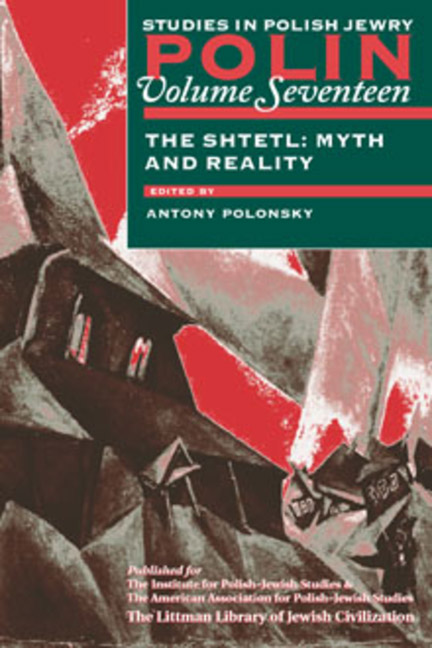Book contents
- Frontmatter
- Dedication
- Editors and Advisers
- Preface
- Polin
- Polin: Studies inPolish Jewry
- Contents
- Note on Place Names
- Note on Transliteration
- List of Abbreviations
- PART I THE SHTETL: MYTH AND REALITY
- PART II NEW VIEWS
- PART III DOCUMENTS
- PART IV THE SIXTY-FIFTH ANNIVERSARY OF EVENTS IN PRZYTYK: A DEBATE
- PART V REVIEWS
- Chone Shmeruk, Hakeriyah lenavi: meḥkerei historiyah vesifrut, edited by Israel Bartal; Chone Shmeruk, Ayarot ukerakhim: perakim beyetsirato shel shalom aleikhem, edited by Chava Turniansky
- Anna Michałowska, Między demokracją oligarchią: Władze gmin żydowskich w Poznaniu i Swarzędzu
- Magdalena Sitarz, Yiddish and Polish Proverbs: Contrastive Analysis Against Cultural Background
- Shmuel Feiner and David Sorkin (eds.), New Perspectives on the Haskalah
- Brian Porter, When Nationalism Began to Hate: Imagining Modern Politics in Nineteenth-Century Poland
- Irena Janicka-Świderska, Jerzy Jarniewicz, and Adam Sumera (eds.), Jewish Themes in English and Polish Culture
- Nancy L. Green (ed.), Jewish Workers in the Modern Diaspora
- Gertrud Pickhan, ‘Gegen den Strom’. Der Allgemeine Jüdische Arbeiterbund ‘Bund’ in Polen, 1918–1939
- Anna Cichopek, Pogrom Żydów w Krakowie, 11 sierpnia 1945 r.
- Michał Horoszewicz, ‘Przez dwa millenia do rzymskiej synagogi’: Szkice o ewolucji postawy Kościoła katolickiego wobec Żydów i judaizmu
- OBITUARIES
- Notes on the Contributors
- Glossary
- Index
Nancy L. Green (ed.), Jewish Workers in the Modern Diaspora
from PART V - REVIEWS
- Frontmatter
- Dedication
- Editors and Advisers
- Preface
- Polin
- Polin: Studies inPolish Jewry
- Contents
- Note on Place Names
- Note on Transliteration
- List of Abbreviations
- PART I THE SHTETL: MYTH AND REALITY
- PART II NEW VIEWS
- PART III DOCUMENTS
- PART IV THE SIXTY-FIFTH ANNIVERSARY OF EVENTS IN PRZYTYK: A DEBATE
- PART V REVIEWS
- Chone Shmeruk, Hakeriyah lenavi: meḥkerei historiyah vesifrut, edited by Israel Bartal; Chone Shmeruk, Ayarot ukerakhim: perakim beyetsirato shel shalom aleikhem, edited by Chava Turniansky
- Anna Michałowska, Między demokracją oligarchią: Władze gmin żydowskich w Poznaniu i Swarzędzu
- Magdalena Sitarz, Yiddish and Polish Proverbs: Contrastive Analysis Against Cultural Background
- Shmuel Feiner and David Sorkin (eds.), New Perspectives on the Haskalah
- Brian Porter, When Nationalism Began to Hate: Imagining Modern Politics in Nineteenth-Century Poland
- Irena Janicka-Świderska, Jerzy Jarniewicz, and Adam Sumera (eds.), Jewish Themes in English and Polish Culture
- Nancy L. Green (ed.), Jewish Workers in the Modern Diaspora
- Gertrud Pickhan, ‘Gegen den Strom’. Der Allgemeine Jüdische Arbeiterbund ‘Bund’ in Polen, 1918–1939
- Anna Cichopek, Pogrom Żydów w Krakowie, 11 sierpnia 1945 r.
- Michał Horoszewicz, ‘Przez dwa millenia do rzymskiej synagogi’: Szkice o ewolucji postawy Kościoła katolickiego wobec Żydów i judaizmu
- OBITUARIES
- Notes on the Contributors
- Glossary
- Index
Summary
This collection of documents is the result of a research project carried out by scholars from universities and research institutes in the United States and western Europe. The volume contains archival documents, articles from the press, and memoirs recording various aspects of the life of Jews—mainly workers and craftsmen— in the countries of settlement from the 1880s until the 1940s. The research agenda was to conduct a comparative analysis of the situation of Jewish migrants from east-central Europe in the six cities regarded as the centres of Jewish immigration in the modern era: New York, Buenos Aires, London, Paris, Amsterdam, and Berlin.
The editor divides the material into four thematic groups; manuscripts in languages other than English are translated. The conceptual framework of this book is interesting and, to my mind, right on target. The preface contains basic data on the scope and history of migration movements to each city, points out characteristic features, and addresses the legal systems and objective conditions of the settlement processes. Sparing yet sufficient commentary precedes each document. The source base is impressive: apart from printed sources, including fragments from diaries and memoirs, the authors have gathered a great deal of material from state archives, the YIVO Institute for Jewish Research, private collections, and the Jewish press (in many languages). It is important to note, however, that the contributors do not limit themselves to Jewish sources and publications. They also include administrative reports, municipal regulations from non-Jewish milieux, and newspaper articles written by non-Jews.
The first section, ‘Daily Life and Work’, contains materials concerning living conditions, labour, employer–employee relationships, the professional structure of the Jewish population and the Jews’ attempts to adapt to the new social and political reality (for example, by working on the sabbath), personal bonds and relationships, neighbourhood communities, and leisure and entertainment. There are also documents concerning co-operation and antagonism between the ‘new’ and the ‘old’ immigration. In the case of the United States, these relationships involved the socalled Russian Jews (all the Jews coming from east-central Europe) and the German Jews, who had settled there earlier. This part, like the next one, highlights a clash between generations that grew sharper with each wave of immigrants. Such conflicts accompanied Jewish families almost from the moment of their arrival in America, Argentina, or other Western countries.
- Type
- Chapter
- Information
- The Shtetl: Myth and Reality , pp. 434 - 437Publisher: Liverpool University PressPrint publication year: 2004

